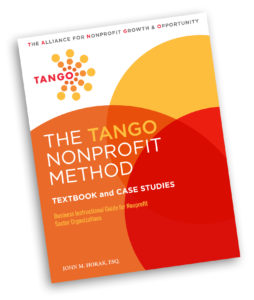It’s Never too Early to Start Your Annual Campaign
May 23, 2020
Jayne Agency – The Unexpected “Generation Gap” in 501c3 Staff Engagement
May 28, 2020TANGO Alliance Insists Nonprofits Be Accountable
Tango Alliance Insists Nonprofits Be Accountable for Outcomes is Jack Horak’s take on why sophisticated donors want to know how their financial investment is achieving significant impact. Jack is co-founder of The Alliance for Nonprofit Growth and Opportunity (TANGO). Here’s what he has to share:
The Stanford University Press recently published the third edition of The Nonprofit Sector: A Research Handbook. The title of Chapter 16 is The Outcomes Movement in Philanthropy and the Nonprofit Sector. It was written by Paul Brest, the former President of the William and Flora Hewlett Foundation and Dean of Stanford Law School. Readers not familiar with the term “outcomes” may recognize synonyms and related terms such as venture philanthropy, impact investing, logic models, theories of change, social rate of return, and others.
Chapter 16 adroitly hits the sweet spot between the subject matter’s depth and breadth. It can get newcomers up to speed quickly while simultaneously enhancing the thought of those already well-schooled on the topic. It qualifies as a “must read.”
I decided to write on the topic because I believe the “outcomes movement” is the most important development in the sector in decades — not so much because of its ability to deliver on its promise of a more objective system to measure nonprofit performance (still an unknown), but because of the overdue conversation it is forcing the sector to have with itself. The movement has value as a catalyst for change separate and apart from any value arising from the deliverables it brings to the table.
Assume Nonprofit A operates to treat addiction. It can count the number of people treated and measure the cost of each treatment cycle with some simple arithmetic. But, what about client outcomes after they leave the program? How many turned their lives around permanently and how many did not? What is the value to the community generally, and the spouse and children specifically, of an addict father who stays clean permanently to become a net contributor to his community and family?
The value proposition of Nonprofit A’s work is higher to the extent lives are turned around and lower to the extent they are not. The outcomes movement arose because by tradition and practice nonprofits have not tried to measure their outcomes, and the argument is that they should try to find a way to do so. In nonprofit A’s case it would, presumably, be required to track and analyze how its clients did for some reasonable future period – admittedly a tall order.
Brest notes that after joining the Hewlett Foundation in 2002 “he learned that its board and staff treated general operating support almost as an end in itself, rather than as an effective means to achieve the foundation’s and grantee’s shared goals…..[m]ost of the foundation’s programs did not have overarching strategies, nor did they ask applicants to articulate their intended outcomes and plans for achieving them….” and that when participants were pressed to “describe the intended outcomes” their “response [was] focused on the intrinsic value of the dialogue. The evaluators were concerned not with tracking outcomes but with reviewing the conversation process.”
Brest maintains that “virtually every activity engaged in by a nonprofit organization is at least implicitly intended to achieve a social or environmental outcome…” and “[a]ll things considered managing to outcomes allows for the most effective use of an organization’s resources and redounds to the advantage of both beneficiaries and funders.” Efficiency and effectiveness are concepts hard wired into the human project and it makes sense to incorporate them into our philanthropic endeavors to the extent we can.
Tango Alliance Insists Nonprofits Be Accountable for Outcomes
The outcomes movement has worthy and capable critics. As one example, Brest quotes William Schambra (formerly of the Hudson Institute) to the effect that “[o]ur vast, bewildering, and ever growing profusion of nonprofits — in all their naive, amateurish, bumbling, redundant glory — may upset all those who want to see social services delivered in a neat, orderly, rationalized and centralized way…….[but] this is a small price to pay for the education in democratic self-government provided by our thick organic, local network of civic associations.”
Brest’s response is modest and compelling. The movement is still relatively new (he dates it to the 1990s) and the degree of difficulty is not lost on the many smart and competent people who have been working on the issue for more than two decades. It is a work in process not a finished product; and the people who have been working on the issue have produced a solid body of academic, sociological, and statistical work that can be found easily with an internet search. You could start with the Webpage of the Hewlett Foundation and proceed from there.
But let me circle back to my argument that the outcomes movement is the most important development in decades.
First, at its core, the outcomes movement is an accountability movement and there is no reason not to hold nonprofit boards and management accountable for the work they do. Board and management should not be able to hide behind their mission statement. Neither the “intrinsic value of the dialog” nor the “value of the conversation” is the mission – the mission is to produce outcomes. It’s like the difference between a pass fail and a fully graded college course — we need to see the grades.
Second, the outcomes movement is not an all or nothing proposition. Outcomes measures can be one component part of a more comprehensive system of accountability and performance measures.
The movement’s touch point is the “uncanny valley” between the two sides of our existence — the earthy objective and quantifiable world of numbers and budgets and the sublime subjective qualitative world we describe with inexact words like “turning your life around” and with examples like an addict father who stays clean. While I doubt the movement will ever transform the qualitative into the quantitative — there is value to be found in testing the limits of quantification and in being intellectually honest about the limit. Donors should be told both the cost per visit and the extent to which the long-term life outcomes are measured (or not measured) after clients leave the program. The information contained in the distinction between the two has intrinsic value in and of itself.
Third, there is no room for naive, amateurish, bumbling in the twenty first century social services sector – there is a need for high end professional competence and performance on every level and as to every function.
Modern social service organizations are enterprises as complex and difficult to operate as any comparably sized business. They are joined at the hip with federal and state government funding sources, and the accompanying regulatory, licensure, governance, billing, and reporting requirements; and they have staffing, property management, risk management, and other operational issues that require talented management and daily attention.
For example – there is no room or excuse for common phenomenon such as board members not understanding the role of independent auditors or realizing that management answers to the board (not the other way around). Too often mergers or similar transactions that make great common and economic sense do not happen because neither CEO wants to retire or move to another job, and because neither board is willing to stand up to its CEO. I have told boards that doing this is fiduciary malpractice because they are subordinating their fiduciary duty to the mission to the personal interests of the CEO. I once heard (and will never forget) a board member’s whispered reply to the effect of “who cares, we are only volunteers and can’t be sued.” I could go on – but will not belabor the point – which is that there is much room for improvement.
Finally, let me close with the caveat that we not put the cart before the horse – that we do not take the last step before the first step. What I mean is that we already know what needs to be corrected to increase outcomes and performance (see the above examples), and we need not wait for the outcomes movement to run its course before taking them on. How to do so is a discussion for a different day and I will come back to it in the future. Stay tuned to Tango Alliance for next steps.
Tango Alliance Insists Nonprofits Be Accountable for Outcomes was first posted at INSIDE CHARITY
For more articles like Tango Alliance Insists Nonprofits Be Accountable for Outcomes VISIT HERE


1 Comment
[…] Earlier this year, I published an article that summarizes and discusses a Chapter of Stanford University Press’s newly published book, The Nonprofit Sector: A Research Handbook. You can read the article in the publication Inside Charity. […]